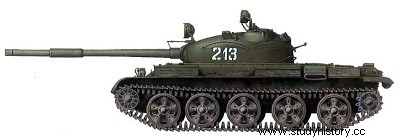
Type :main battle tank
Crew :4 men
Armament :a 115 mm U-5TS gun; a coaxial 7.62 mm PKT machine gun; a DShK 12.7 mm anti-aircraft machine gun (optional).
Armour :minimum 20mm; maximum 170 mm.
Dimensions:
length (overall):9.77 m;
length (hull): 6.71 m;
width 3.35 m;
height (without the anti-aircraft weapon) 2.40 m.
Weight in combat order :36.5 t.
Ground pressure :0.72 kg/cm2.
Engine :Model V-2-62 12 cyl. water-cooled diesel, developing 709 hp at 2,200 rpm.
Performance :
road speed 50 km/h;
range (without additional tanks) 500 km;
vertical obstacle 0.80m;
straight cut :2.80 m;
slope :60%.
Service time :introduced in the Soviet army in 1963.
Used by Afghanistan East Germany, Bulgaria, Hungary, India, Iraq, Israel, Libya, Poland, Romania, Syria, Czechoslovakia, USSR.
Created at the end of the 1950s to succeed the T-54/T-55 series, the T-62 made its first official release in May 1965. Resembling, at first sight, the T-54, it however has a more longer and wider, a new turret, a new gun. It is easily distinguished from the T-54 by the regular spacing of its road wheels (while the T-54 has a larger space between its first and second wheels) and by the design of its gun.
The hull of the T-62 is an all wrought steel assembly. whose glaze is 100 mm thick. The armor of the turret, in cast steel, has a thickness varying from 170 mm at the front to 60 mm at the rear. The driver is at the front of the hull, on the left; the other three crew members are in the turret:the commander and the gunner on the left, the loader on the right. Engine and transmission are at the rear.
The suspension, of the proven "torsion bar" type, has five road wheels, the tension wheel at the front and the sprocket at the rear . The U-5TS smoothbore cannon offers +170 to -40 elevation fire. A 7.62mm PKT machine gun is paired with it. When it first appeared, the T-62 did not have an anti-aircraft machine gun, but in recent years many of these tanks have been fitted with the standard DShK 12.7 mm weapon, mounted on the cupola of the loader. The tanks thus armed received the name T-62A.
The shells carried are of three types:HE, FSAPDS and HEAT. The FSAPDS shell has a muzzle velocity of 1,680 m/s and an effective range of 1,600 ni. When this projectile is fired. the sabot (segment) detaches from the shell, the fins of which then unfold to stabilize its trajectory. According to Israeli reports, this projectile can penetrate 300 mm armor at a distance of 1,000 m. The barrel is loaded manually but, after each shot, it automatically resumes a determined angle to allow the ejection of the casing.
The latter, on leaving the breech, slides down a slide to a small hatch located at the rear of the turret and through which it is evacuated. This system, however, seems insecure. The gun, which has an average rate of fire of 4 rounds/min, is stabilized in the two firing sectors. The ammunition load is 40 115 mm shells and 3,500 7.62 mm cartridges.
The T-62 is equipped with an NBC system, infrared driving lights, an infrared searchlight on the commander's cupola and another infrared searchlight installed to the right of the main armament, to which it is twinned to allow the tank to attack at night The tank can ford without preparation to a depth of 1.40 m.
A snorkel can be erected on the outfitter's hatch, with guy wires keeping it in a vertical position. Thus equipped, the tank can ford to a depth of nearly 5.50 m. When not in use, the snorkel, disassembled in sections, is carried in the rear of the tank.
Like the T-55, the T-62 can emit its own screen of smoked by the injection of vaporized diesel fuel into the exhaust pipes located on either side of the hull. Additional fuel tanks can be fitted at the rear to increase vehicle range. As the tank goes into action, the driver drops these tanks.
The T-62 was used in both Egyptian and Syrian force operations. Less sophisticated than Western tanks, it proved robust and reliable. The number of T-62s produced by the USSR is estimated at more than 15,000:"but it does not seem that this tank was also built in other Warsaw Pact countries, as was the case for the T- 54/T-55 Although the Soviets have introduced a new tank called the T-64/T-72 into service, it is believed that production of the T-62 continues and that this model will still be used by the USSR for several more years. years.
